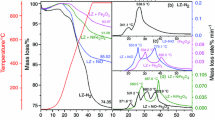Abstract
Pressurized oxy-combustion is a promising technology that can significantly reduce the energy penalty for CO2 capture in coal-fired power plants. However, higher pressure might enhance the production of strong acid gases, including SO3 and NO2, which will lead to higher rates of corrosion. In this study, we investigated a reduced but combined SOx and NOx mechanisms and the synergistic formation of SO3 and NO2 was kinetically evaluated under different pressures and temperatures up to 15 atm and 1100 °C. The calculation results show that the interaction of SOx and NOx significantly accelerates the conversion rates of SO2 to SO3 and NO to NO2, and the acceleration is much stronger at elevated pressures and comparatively low temperatures. With a strong interaction between SOx and NOx due to elevated pressures, the formation pathways of SO3 and NO2 through HOSO2 + O2 = HO2 + SO3 and HO2 + O = NO2 + OH, respectively, are dramatically promoted. These two reactions are linked by the reaction SO2 + OH + M = HOSO2 + M, resulting in a ‘strong’ cycle, which can be represented by the global reaction NO + SO2 + O2 = NO2 + SO3. This cycle is the major route for the formation and destruction of both SO3 and NO2 at elevated pressures.





Similar content being viewed by others
References
Axelbaum RL, Kumfer B, Wang X (2016) Advances in pressurized oxy-combustion for carbon capture. CornerStone 4(2):52–56
Hong J, Chaudhry G, Brisson JG, Field R, Gazzino M, Ghoniem AF (2009) Analysis of oxy-fuel combustion power cycle utilizing a pressurized coal combustor. Energy 34(9):1332–1340
Gopan A, Kumfer BM, Axelbaum RL (2015) Effect of operating pressure and fuel moisture on net plant efficiency of a staged, pressurized oxy-combustion power plant. Int J Greenh Gas Control 39:390–396
Ahn J, Okerlund R, Fry A, Eddings EG (2011) Sulfur trioxide formation during oxy-coal combustion. Int J Greenh Gas Control 5:S127–S135
Stanger R, Wall T (2011) Sulphur impacts during pulverised coal combustion in oxy-fuel technology for carbon capture and storage. Prog Energy Combust Sci 37(1):69–88
Santos S, Duarte A, Bordado J, Gomes J (2016) New process for simultaneous removal of CO2, SOx and NOx. Ciência & Tecnologia dos Materiais 28(2):106–111
Lutz AE, Kee RJ, Miller JA (1988) SENKIN: A FORTRAN program for predicting homogeneous gas phase chemical kinetics with sensitivity analysis. Sandia National Labs, Livermore
Larson RS (1996) PLUG: A Fortran program for the analysis of plug flow reactors with gas-phase and surface chemistry. Sandia Labs, Livermore
Design R (2010) CHEMKIN/CHEMKIN-PRO theory manual CHEMKIN® Software. August, pp 1–360
Wei X, Han X, Schnell U, Maier J, Wörner H, Hein KR (2003) The effect of HCl and SO2 on NOx formation in coal flames. Energy Fuels 17(5):1392–1398
Mueller M, Yetter R, Dryer F (2000) Kinetic modeling of the CO/H2O/O2/NO/SO2 system: implications for high-pressure fall-off in the SO2 + O (+M) = SO3 (+M) reaction. Int J Chem Kinet 32(6):317–339
Gomes J, Santos S, Bordado J (2015) Choosing amine-based absorbents for CO2 capture. Environ Technol 36(1):19–25
Ting T, Stanger R, Wall T (2013) Laboratory investigation of high pressure NO oxidation to NO2 and capture with liquid and gaseous water under oxy-fuel CO2 compression conditions. Int J Greenh Gas Control 18:15–22
Smith GP, Golden DM, Frenklach M, Moriarty NW, Eiteneer B, Goldenberg M, Bowman CT, Hanson RK, Song S, Gardiner Jr, W (2011) GRI-Mech 3.0, 1999. URL http://www.me.berkeley.edu/gri_mech
Glarborg P, Kubel D, Dam-Johansen K, Chiang HM, Bozzelli JW (1996) Impact of SO2 and NO on CO oxidation under post-flame conditions. Int J Chem Kinet 28(10):773–790
Dayma G, Dagaut P (2006) Effects of air contamination on the combustion of hydrogen—effect of NO and NO2 addition on hydrogen ignition and oxidation kinetics. Combust Sci Technol 178(10–11):1999–2024
Wang X, Li S, Adeosun A, Li Y, Vujanović M, Tan H, Duić N (2017) Effect of potassium-doping and oxygen concentration on soot oxidation in O2/CO2 atmosphere: a kinetics study by thermogravimetric analysis. Energy Convers Manag 149:686–697
Design R (2007) CHEMKIN theory manual. San Diego
Gopan A, Kumfer BM, Phillips J, Thimsen D, Smith R, Axelbaum RL (2014) Process design and performance analysis of a staged, pressurized oxy-combustion (SPOC) power plant for carbon capture. Appl Energy 125:179–188
Baulch D, Cobos C, Cox R, Frank P, Hayman G, Just T, Kerr J, Murrells T, Pilling M, Troe J (1994) Evaluated kinetic data for combustion modeling. Supplement I. J Phys Chem Ref Data 23(6):847–848
Li B, Sun Z, Li Z, Aldén M, Jakobsen JG, Hansen S, Glarborg P (2013) Post-flame gas-phase sulfation of potassium chloride. Combust Flame 160(5):959–969
Armitage J, Cullis C (1971) Studies of the reaction between nitrogen dioxide and sulfur dioxide. Combust Flame 16(2):125–130
Acknowledgements
The authors gratefully acknowledge the financial support of the National Key Research and Development Program of China (No. 2016YFB0600605), the National Natural Science Foundation of China (Nos. 51676157 and 5161101654), the U.S. Dept. of Energy (Award # DE-FE0009702), and the Consortium for Clean Coal Utilization (CCCU) at Washington University in St. Louis. We would also like to thank Mr. James Ballard at Washington University in St. Louis for editing the manuscript for language errors.
Author information
Authors and Affiliations
Corresponding author
Rights and permissions
About this article
Cite this article
Wang, X., Adeosun, A., Yablonsky, G. et al. Synergistic SOx/NOx chemistry leading to enhanced SO3 and NO2 formation during pressurized oxy-combustion. Reac Kinet Mech Cat 123, 313–322 (2018). https://doi.org/10.1007/s11144-017-1327-3
Received:
Accepted:
Published:
Issue Date:
DOI: https://doi.org/10.1007/s11144-017-1327-3




